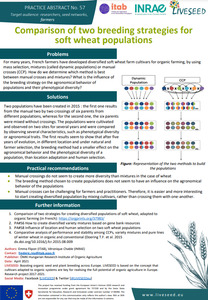{Tool} Comparison of two breeding strategies for soft wheat populations (Liveseed Practice Abstract). Creator(s): Flipon, Emma and Chable, Véronique. Issuing Organisation(s): ITAB - Institute for Organic Agriculture and Food, INRAE - National Research Institute for Agriculture, Food and Environment. Liveseed Practice Abstract, no. 57. (2021)
|
PDF
- Published Version
- English
480kB | |
![[thumbnail of 2022-07-26 21_06_25-PowerPoint Presentation.png]](/39906/4.hassmallThumbnailVersion/2022-07-26%2021_06_25-PowerPoint%20Presentation.png)  Preview |
Image (PNG)
- Cover Image
- English
173kB |
Document available online at: https://www.liveseed.eu/wp-content/uploads/2021/04/PA57_Comparison-of-two-breeding-strategies-for-soft-wheat-populations.pdf
Summary in the original language of the document
Practical recommendations: Manual crossings do not seem to create more diversity than mixtures in the case of wheat. The breeding method chosen to create populations does not seem to have an influence on the agronomical behavior of the populations. Manual crosses can be challenging for farmers and practitioners. Therefore, it is easier and more interesting to start creating diversified population by mixing cultivars, rather than crossing them with one-another.
| EPrint Type: | Practice tool |
|---|---|
| What problem does the tool address?: | For many years, French farmers have developed diversified soft wheat farm cultivars for organic farming, by using mass selection, mixtures (called dynamic populations) or manual crosses (CCP). How do we determine which method is best between manual crosses and mixtures? What is the influence of the breeding strategy on the agronomical behavior of populations and their phenotypical diversity? |
| What solution does the tool offer?: | Two populations have been created in 2015 : the first one results from the manual two by two crossings of six parents from different populations, whereas for the second one, the six parents were mixed without crossings. The populations were cultivated and observed on two sites for several years and were compared by observing several characteristics, such as phenotypical diversity or agronomical traits. The first results seem to show that after five years of evolution, in different location and under natural and farmer selection, the breeding method had a smaller effect on the agronomical behavior and the phenotypical diversity of a population, than location adaptation and human selection. |
| Country: | France |
| Type of Practice Tool: | Practice abstracts |
| Keywords: | plant breeding, wheat |
| Agrovoc keywords: | Language Value URI English plant breeding http://aims.fao.org/aos/agrovoc/c_5956 English wheat http://aims.fao.org/aos/agrovoc/c_8373 |
| Subjects: | Crop husbandry > Production systems > Cereals, pulses and oilseeds Crop husbandry > Breeding, genetics and propagation |
| Research affiliation: | European Union > Horizon 2020 > Liveseed European Union > Horizon 2020 > Liveseed > Liveseed tools France > INRAe - Institut national de recherche pour l’agriculture, l’alimentation et l’environnement France > ITAB - Institut Technique en Agriculture Biologique European Union > Organic Farm Knowledge |
| Horizon Europe or H2020 Grant Agreement Number: | 727230 |
| Related Links: | https://organic-farmknowledge.org/tool/39906 |
| Project ID: | ofk |
| Deposited By: | Ortolani, Dr. Livia |
| ID Code: | 39906 |
| Deposited On: | 28 May 2021 09:03 |
| Last Modified: | 02 May 2024 10:32 |
| Document Language: | English |
| Status: | Published |
Repository Staff Only: item control page

 Download Statistics
Download Statistics Download Statistics
Download Statistics
